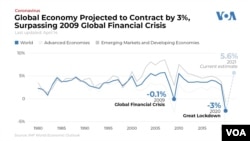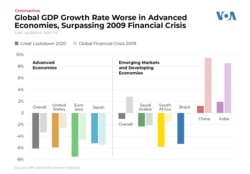All signs are pointing to a global economic crisis of proportions not seen in decades in the face of the coronavirus pandemic crisis.
On Wednesday, the International Monetary Fund estimated that the global economy would shrink by 3 percent in 2020, a slowdown 30 times worse than what the world experienced in 2009, when the global financial crisis caused growth to shrink by 0.1 percent.
The new forecast contrasts sharply from the IMF’s projections just three months ago, when the organization anticipated a 3.3 percent global economic expansion. It also comes as the United States is making a modest effort to prop up other countries’ economies with increased contributions to international financial organizations such as the IMF and the United States Agency for International Development (USAID).
Announcing a revision of her agency’s World Economic Outlook, IMF chief economist Gita Gopinath said that the current crisis will be “the worst recession since the Great Depression” of the 1930s.
The implications for countries that typically rely on foreign aid are particularly dire, the IMF said.
“Emerging and frontier market economies are facing the perfect storm,” the fund said in its Global Financial Stability report.
Even as their economies are crippled by the global shutdown, emerging market countries have watched as global investors shifted unprecedented amounts of money away from them in an effort to find a haven.
As a result, countries already struggling to service debt will face possible default if international lenders do not take steps to restructure their loans.
Gopinath said a massive, coordinated global response will be necessary to help the world economy recover.
As part of its response, the U.S. Congress recently authorized hundreds of millions of dollars in additional direct foreign aid to countries struggling to contain the disease, and has allocated several billion dollars to international economic development institutions.
But experts say that after years of under-investment in global health security measures, the current U.S. commitment amounts to no more than a “down payment” on the effort that will be needed to address the current crisis and to blunt the effects of future pandemics.
U.S. leadership urged
“This is an initial start, but we’re going to need really significant political leadership” from the United States, said Erin Collinson, director of policy outreach for the Center on Global Development. “I certainly hope to see a greater effort on the international front from the U.S. moving forward,” she added.
InterAction, an alliance of global non-governmental organizations, issued a statement when massive economic stimulus legislation was passed calling for the U.S. to take the lead in a global response.
“American leadership has proven pivotal at many times throughout modern history, and American leadership is needed now to combat this pandemic,” InterAction said.
First wave
Aid dollars allocated by the U.S. government have come in two waves. In mid-March, lawmakers passed their first piece of legislation responding to the COVID-19 outbreak, an $8.3 billion package that included an allocation of $985 million to the USAID. The funding was meant to support USAID’s Global Health and International Disaster relief efforts, with $250 million set aside specifically for its economic support fund.
USAID, which supervises multiple U.S. foreign aid programs around the world, had offices in more than 100 countries at the end of fiscal years 2019. The largest recipients of U.S. foreign aid are, in order, Iraq, Afghanistan, Israel, Egypt and Jordan. But tens and even hundreds of millions of dollars are allocated to countries across the globe each year, from China to Central America.
Second wave
The second wave of foreign aid funding came with the Coronavirus Aid, Relief, and Economic Security Act (CARES Act), a much larger bill that allocated $2.2 trillion toward battling the disease. Most of that funding was directed at domestic relief efforts.
However, the CARES Act contained an additional $703 million in direct foreign aid, made up of $350 million for the State Department’s Migration and Refugee Assistance program, $259 million for USAID’s International Disaster Assistance fund, and an additional $95 million for the agency’s operating expenses.
World Banks gets billions more
In addition to direct aid to other countries, the legislation provides $88 million in supplemental funding for the Peace Corps, and directs the Treasury Department to increase the U.S. investment in a number of intergovernmental organizations.
The law provides more than $3 billion in additional funding for the World Bank’s International Development Association, as well as funding for the World Bank’s International Finance Corporation. An additional $7.3 billion was allocated to increase the capital stock of the African Development Bank.
The World Bank has for years worked with developing countries around the world to modernize their economies and to meet specific development goals, including the eradication of hunger and diseases, universal education, women’s rights and more. The World Bank Group provides funding in the form of loans and grants, as well as advisory services, operating in dozens of countries in some of the most economically challenged regions of the globe, including sub-Saharan Africa and Southeast Asia.
International Monetary Fund
The CARES Act also instructs the Treasury Department to increase the IMF’s access to credit from the department by $28.2 billion. However, that falls far short of what other governments say the IMF needs to respond to the crisis.
With its 189 member countries, the IMF is designed to foster economic cooperation across borders, and to provide economic assistance and advisory services to countries struggling with economic problems.
This week, the agency announced an emergency debt relief program for countries in need of economic assistance to address the COVID-19 pandemic. Among the 25 recipients were large African nations, including the Democratic Republic of Congo, Madagascar and Mozambique, and numerous other countries, including Nepal, Yemen and Tajikistan.









